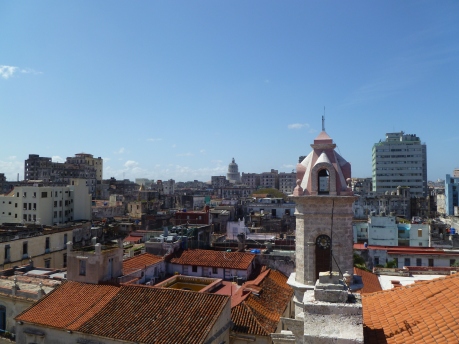
We had waited patiently for this time. This was the focus of our Cuban experience. Oh yes, sailing around Cuba from Santiago to de Vita had been an experience of the pioneering type – in fact much more in that spirit than we had imagined, but for our land tour we were tourists proper. How different would that be? Could the two experiences of Cuba be reconciled to make up a picture of Cuba Real?
But of course we were not alone in this endeavour , our eldest son Chris, daughter-in-law Tanvi and 7 month old grandson Charlie were coming to join us from London– in fact Tanvi had instigated and planned the whole event with the help of the holiday company Vamos Cuba. Our 10 day bespoke tour was to start in Havana for 3 days, then head west to the agricultural region of Vinales for 2 days, before turning back to the east taking in all the major cities and sites along the way before returning to Resolute in Marina De Vita once more. 2 weeks of glorious unadulterated tourism!
First we had to get to our rendez-vous in Havana. Janet, the ever-helpful Marina Manager at De Vita had suggested we take one of the hour-long, daily flights from Holguin airport but when she had made some enquiries about flights she had been dismayed to find them fully booked quite far in advance. This could have been because the Pope was visiting Havana (an event of which she knew nothing about even though it was happening only 300 or so miles away in the capital of her Country). We decided it all sounded a little uncertain, so with the dodgy internet link in the internet room at the marina we made enquiries about the twice daily coach from Holguin to Havana, known as the Viazul bus. Viazul – a government run company of course – specialised in tourist travel from city to city within Cuba. The former Chinese buses were supposedly air-conditioned and comfortable even boasting an on board toilet. As our trip was to take a full day (over10 hours) these details were important. To ensure this service was out of the reach of the rank and file Cuban, the tickets could only be bought using CUC (the tourist currency linked to the US dollar). Our single trip would cost us 44CUC each as opposed to the 100 CUC the flight would reputedly cost. Sure enough we were able to get on the website (many other sites are blocked) and much to our delight we could even book online. Janet was astonished by this – she had obviously never seen the like before. Our problem was that there was no printer on which to print off our booking confirmation (we have a printer on board the boat which can only be used with mains power but we were at anchor). We could e-mail it to Janet we thought, as she had a very antiquated printer in her office, in fact it seemed to take up most of her desk-space. Yes, she said, but the problem is I cannot get an email from you if you have a foreign email address. It transpired she was only permitted to receive e-mails from Cuban sources – but she advised us that her boss had the capability on his more privileged system to receive any emails, so we could send our request to him, he could forward it via the Cuban system to Janet and then her daisy-wheel printer could indeed print it for us. Eureka! Actually, by the time we had solved this conundrum, Colin had managed to download the confirmation document onto a USB stick and transferred it to his Kindle Fire….even more astonishment from Janet! Armed with this we had trudged to the grotty little Holguin Viazul office beside the even grottier bus station, as the confirmation had to be exchanged for a ticket. However, the very unhelpful agent explained we could buy a ticket today but only exchange our booking confirmation 1 hour before the bus left. So we had a day in Holguin to ponder why we had booked on line. And an early start on our day of travel as the bus left at 0745 so that meant getting to the office at 0645 and Holguin was about 50 minutes from the boat at de Vita! Not to worry, said Janet back in de Vita, as we advised her that we would need a taxi just before 6 – no problem…..so that was the plan to get us to Havana the same day that Chris, Tanvi and Charlie flew in from London.
In fact, the plan went well. The coach was indeed, comfortable and chillily, over air-conditioned, though the condition of most of the roads made any attempt at a smooth ride a forlorn hope. Most of the passengers were indeed tourists with a few well-to-do locals largely doing some shorter hops. There were two drivers, taking the driving in turns for about 2 hours stints sometimes worryingly passing the baton of the steering wheel without actually stopping. There were however frequent stops at each town where it was possible to stretch our legs and try to buy some snacks – though not much was on offer anywhere. Good thing we had come prepared. Eventually, after dark we arrived on the outskirts of Havana: Soviet-esque concrete blocks of flats, gigantic ageing factories and then to our relief we stopped at the bus station. Greeted by a plethora of budding taxi offers we plumped for a chap who spoke good English and – as we always instinctively resent the ‘in your face’ manner of service provision – this chap seemed to hang back a little and patiently wait. We agreed a price to our destination and he showed us, past the rank of quite plush by Cuban standards cars to his very aging Lada round the back of the station. We were now getting used to being transported in vehicles with no seat belt, no operating gauges on the dashboard, no doors or windows opening from the inside at least – but on the plus side – many boasting flash stereo systems circa 1989! We trundled off into Havana, with us straining our eyes to catch our first glimpses of this enigmatic city. Through the dull concrete suburbs first and then into the more interesting squares and narrow ancient cobbled alleys….until we stopped…but it soon became apparent that we were not at our destination, instead the driver was asking directions of some locals sitting on the step of their dilapidated abode. More criss-crosses and another stop to ask the way to our designated street. No road names seemed to be visible, and each street looked much the same – indistinguishable from the last in what seemed like a maze. About seven stops and starts later we arrived at what the driver thought was our destination – a very tall, balconied 19th century building crammed between others in a much poorer state. The blue insignia on the door assured us this was a Casa Particulares – a Cuban homestay bed and breakfast…..but we just could not get an answer from the doorbell which seemed strange. The patient taxi driver would not leave us until the door had been answered and quite a committee of neighbours soon congregated around us jabbering helpful advice. Eventually a door alongside ours opened and a chap invited us in for coffee in his vestibule whilst he phoned the proprietor of the Casa to tell him we had arrived – at least that is what we thought he had said – our poor Spanish making it impossible to know with any certainty.
Slightly dazed and confused, we waited until at last a breathless young man rushed through the door and greeted us in good English. He was the Proprietor of the Casa next door he said, but he was elsewhere in the city when we called – sorry, sorry. He helped us with our bags up seemingly endless stairs and then, joy of joys, we were met by Chris, Tanvi and Charlie who were already ensconced in the apartment. We had made it!
Now let me explain about these Casa Particulares. In the secretive, censored environment of communist Cuba one would presume that the government would want to keep foreign visitors and the local population at arm’s-length. This had certainly been our experience whilst we were sailing from anchorage to anchorage. But Cuba seems full of contradictions and the Casa Particulares scheme is certainly one of them. There are thousands of these Casa’s all over Cuba – all manner of rooms and annexes from extremely basic to wonderfully luxurious, depending on how much the visitor wishes to pay. Under this government scheme casa owners can register their accommodation, pay a monthly tax per room (which has to be paid whether the room is rented or not) and are obliged to register all guests and report their arrival within 24 hours. Rooms are regularly inspected which maintains a high standard everywhere. We were excited to be making use of this scheme – hoping that the interaction with Cuban families in their own homes would give us a privileged insight into the real Cuba.
Casa Aby’s in the heart of old Havana was a great introduction. From the balcony of our room we looked out over the higgledy-piggledy roof tops of the old town – pock marked with centuries of boom and bust attempts at roof extensions and developments. Down in the alley there were street sellers of every sort– bread, biscuits and cakes, ironmongery, meat, fruit and vegetables – even cement – some selling their wares out of the front doors of their homes and others pushing trolleys or carts and shouting or ringing a bell to attract attention. In these ancient tall apartment blocks often their street call would be answered from an overlooking balcony and a basket would be lowered to pay and obtain the wares. Often the street noise was punctuated by the clippety-clop of horse and cart on the cobbles. This we felt was a lifestyle, in this densely packed warren of streets, which had persisted fairly unchanged for centuries.
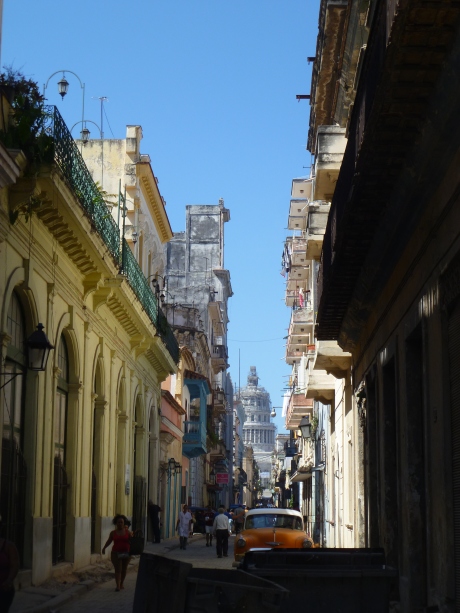
Old Havana
We had only a few days to explore this vast, buzzing city but had been helped to some extent by Vamos Cuba by the offer of an orientation tour of old (vieja) Havana, designated a UN World Heritage site. Margarita was to be our Vamos host for our entire holiday – always contactable via a mobile phone with any problems along the way. She was based in Havana and we were therefore pleased to get to know her as she took us through the crowded cobbled streets on our first day. The walking tour centred around four large plazas and their environs – a distance of a few miles inland from the old harbour (now home to the ubiquitous cruise ships – a newish addition to the Cuban tourist arsenal and hailed by Margarita (a student of tourism at the local university) as an amazing progression. Vieja Havana is kept pristine for the tourists – away from the cobbled streets of our Casa the broad thoroughfares are busy with traffic – a few more modern vehicles here, but mainly still the classic American 1950’s cars in droves, rusty Russian runabouts and taxi’s, horse-drawn carts and carriages, big belching old lorries and buses and coaches of all descriptions and ages. Over the large thoroughfares and back into the little lanes lined with shops and bars each opening into cool, shaded plazas it was easy to imagine at times we were strolling through the streets of any European city – Lisbon came particularly to our mind – but then listening to Margarita’s constant references to the Revolution, the murals, images and statues to revolutionary heroes everywhere, the queues of people outside some banks and shops and the bleak, unadorned shops used by the locals to obtain their rations, one was immediately jarred into a very different reality.
So in a nutshell Havana is an incredible mix. The beautiful 18th century, Italianate Catedral de Cristobel de la Habana, standing proudly in its own atmospheric, baroque square was striking (but Margarita knew little about it – religion is not high on the agenda of the average Cuban it seems – no surprise there). We knew from our own sources that the Pope had visited this very place of worship only the week before. Every plaza was surrounded by eclectic grandiose architecture – once the homes of the rich or the edifices to grand commercial ventures now commandeered since the revolution to government purposes – museums mostly – there are about 20 such museums in old Havana alone – dedicated to everything from playing cards to fire-fighting equipment.

The Cathedral, Havana

View of Havana from Cathedral tower
The only museum we all felt was worth some of our precious time in Havana was the Museo de la Revolucion which is housed with deliberate irony, in the former Presidential Palace, built in the early 20th century, last used by Fulgencio Batista. With its grandiose Versailles-like exterior and its Tiffany interior it aptly epitomises the vulgar excesses the Revolution was striving against. Now, of course, we realised the whole of this exhibit of the glorious revolution was to be taken rather tongue in cheek. Of course there would be propaganda in spades but the arrogant self-certainty of it all was astounding to our European sensibilities. A whole wall, for example, was taken up with a caricature entitled ‘The Cretins’ – a line of very foolish-looking pre-Obama American presidents. We felt rather uncomfortable looking at this surrounded by American tourists! The audacity of it! This set the tone for the whole museum, but it did at least chronicle the whole revolutionary story meticulously – bloodied, bullet-ridden uniforms and equally bullet ridden palace walls and all. We left – having also sampled the outside exhibits of hardware and the motor boat (The Granma) which bought Castro et al to Cuban shores from exile in Mexico – feeling we understood the reasons for the revolution and the main events and characters – especially the brothers Castro and the utterly romantic hero-ego that was Che Guevara of course. As we left, we heard a group of American tourists discussing the museum…….”but gee, they mean well….”was the phrase that bought a smile to our lips!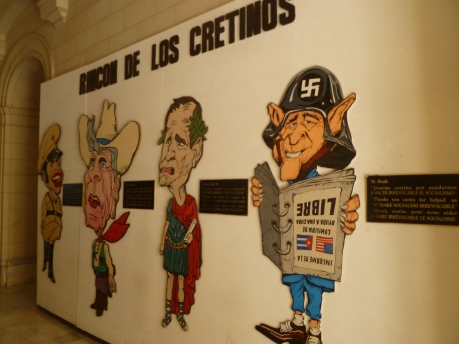
One evening we took a taxi through a tunnel to the two old forts on the opposite side of the bay. The Parque Historico Militar Morro-Cabana. Apart from the obvious historic interest of these two fortresses dating from 1589 (Morro) and 1774 (Cabana), there are spectacular views across the sea and Havana – especially at dusk. To enhance the whole sunset experience in the park there is a popular nightly re-enactment of the firing of the cannon over the harbour. Slightly concerned that little Charlie might not appreciate being too close to a firing cannon, we nonetheless joined the masses to watch this spectacle. We should not have worried. Charlie, so busy with captivating the hearts of his audience with his smiles and his full repertoire of raspberry-blowing and coy giggling, hardly noticed the horrendous bang as the cannon fired not 10 yards from us. After the firing, the whole crowd was immediately galvanised into a frenzy when the heavens opened and it absolutely poured with rain. There was little shelter anywhere nearby except the tiny, smelly guard room where about 10 of us crammed in. Charlie, cosy under his rain hood in his buggy, took all this in his stride and decided, his audience satisfied, to take a nap. After the worst of the rain we took our sodden selves to a restaurant embedded in the battlements – a very atmospheric place to eat but spoilt by the waitress often ignoring us in favour of a soap opera on a small television by the bar. Then back outside the fortresses to search for and eventually find ourselves a taxi back to our casa involving more questioning of the locals to find a path through the maze of identical streets.
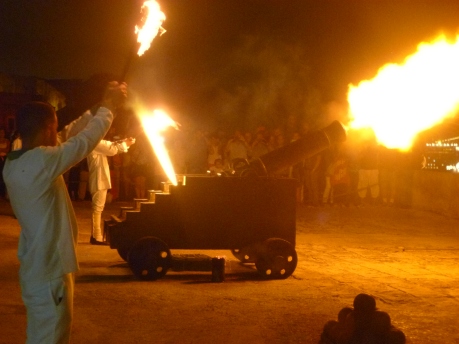
Cannon firing at Fort Morro, Havana
With sore feet from our treks through the city, the next afternoon we decided to take advantage of the ubiquitous hop-on, hop-off, open-topped city tour bus, though somehow the whole outfit seemed a bit dodgy – from the ticket price advertised in all our guide books being 5CUC per person but on further enquiry from the girly guide, no, apparently it was an expensive 10CUC per person – to her advising us we would not be issued with a ticket immediately. However we decided to get on. It was interesting to divine the extent of the city out to the seaside resorts. The normal bus route was disabled, we were told, by a road closure where the new US Embassy had opened – information announced with an annoyed sigh for the inconvenience of it – all due to the indulgence it seemed, of their least favourite neighbour. On the outskirts of the city, we turned a corner and were faced with an enormous open space – the Plaza de la Revolution. Surrounded by grey, utilitarian buildings constructed in the 1950’s today the square is the heart of Cuban government and the venue for any large political rallies. The previous week the Pope had held a mass there. Someone has had the bright idea of creating huge silhouetted murals of the revolutionary heroes on the facades of the buildings. So there was the legendary Che adorning the outside wall of the Ministry of the Interior. To get a better look at it all we decided to hop off the bus, first having to ask the girly guide for our tickets (where the 5 CUC printed price had been scored out in pen and replaced with a 10) but then we were safe in the assurance that with our expensive day pass tickets in our hands we could hop on another bus which we were assured would be along in 20 minutes or so, well before the last bus at 6. Photos taken and interests satisfied we looked for the next bus. Charlie needed his supper and we were all tired but there was nowhere in this vast plaza to sit. We waited and waited until an hour and a half later at 5.45 a bus arrived and the surly driver and gormless girly-guide could not have cared less that we had had such a long wait – in fact the driver was downright rude – shuting the middle doors on Colin. Of course, this was another government run, jobs-for-life ‘service’ – the stark downside of this non-capitalist, monopolistic society. Take it or leave it.
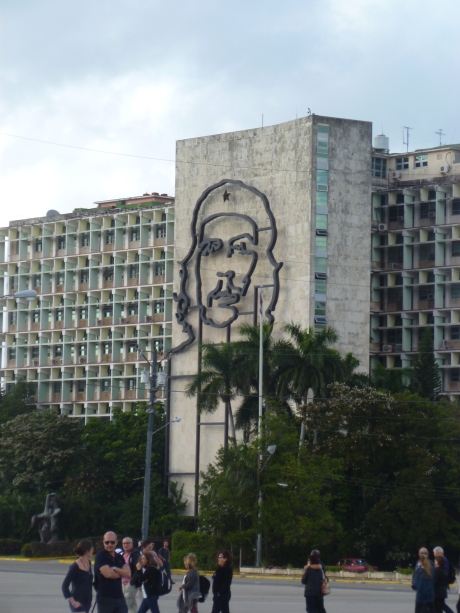
Che mural, Revolution Square, Havana
Despite that somewhat negative experience, we loved Havana and managed to find (with the help of our wonderful Lonely Planet Guidebook) some wonderful eateries and sights. We were captivated by the whole vibrant atmosphere of this unique place where dilapidated , noisy alleyways rub shoulders with vast wide boulevards and shady plazas are overlooked by incredibly eclectic architecture – none grander than the imposing Capitolio building (unfortunately closed and shrouded in scaffolding whilst we were there – but impressive nonetheless), which was obviously a shameless copy of Washington D.C.’s Capital building and housed Cuba’s pre-revolutionary Government from 1929 when it was inaugurated until 1959.
After our time was up, we had to reluctantly move on, literally to pastures new. After a hiccup with our taxi driver Michel being delayed by a problem with his mini-van (which had definitely seen better days even before all his electrics had failed that morning), we were off heading due west out of fume-filled, densely-packed Havana into a patchwork of open fields in clear country air. In the distance were tall limestone monoliths (mogotes). The Valle de Vinales, another UNESCO World Heritage Site, was beckoning us. Tobacco was this area’s reason for being untouched in centuries, so it was right and proper that a tobacco plantation visit was on our agenda that day but not before we stopped to have lunch and a cool, refreshing dip (well, Colin and Chris at least) in a waterfall. None of us being smokers we found it difficult to be too enthusiastic about the tobacco plantation tour but as it literally ‘went with the territory’ we felt it was a must do. We were not disappointed. This was where the best tobacco was grown – possibly the best in the world – which was made into the finest, most expensive and highly-prized cigars. We were told all about the differences in the plant selection producing the best leaves, which were lovingly dried in vast thatched, steep-roofed barns recognisably distinct throughout the area. Of course we were then shown how a cigar was rolled and the difference in the brands. We were even persuaded to have a puff on one of these finest cigars and suddenly it became plausible (to Colin and I at least) why cigar smoking could be considered pleasurable (but don’t worry, we are not about to start!). In Cuba everyone smokes and it is not considered an unnatural thing – just as organic as devouring and enjoying other commonly harvested crops like sugar cane or wheat. Interestingly, this seems to be the perceived wisdom concerning the smoking habit in Cuba – and this in a land where all health care is government funded.
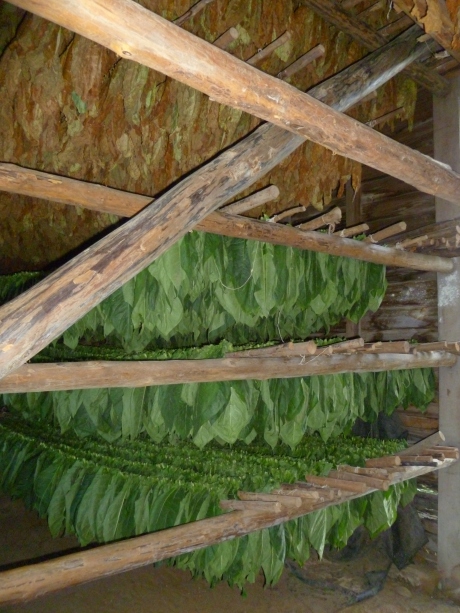
Tobacco drying in barn, Vinales.
Exhausted by our long day we eventually arrived at our beautiful rural casa – with views across fields and fields of tobacco and other crops. Our hosts Magalys and Manolo made us feel extremely welcome with delicious, generously proportioned meals served on the patio in splendid, rural isolation. What a difference a day had made!
The next day, we awoke to cocks crowing and birds singing in our rural idyll. After a very hearty breakfast we met our first ‘guajiros’ – looking for all the world like a cowboy – but, more accurately a local farmer – who had come in his cowboy hat and wellies to take us on an escorted walking tour in the Valley. We were deposited by trusty Michel (whose vehicle was still ailing and had to be parked on hills to ensure the downhill run would jump start it) in the middle of nowhere and taken through endless fields, surrounded by the overarching limestone mogotos and punctuated by majestic royal palm trees, with a running commentary about farming methodology which still used oxen to plough the rust-coloured, rich soil. He explained the cycle of their year and the setting aside of some fields after harvest. Tobacco was the main crop but there was also coffee, sugar cane, oranges, avocados, pineapples and bananas. After a slightly frightening encounter with a river crossing – just a big log over quite a wide deep expanse of water, we stopped at a little hut where a colleague was disappointed to hear we had already had the finer points of tobacco harvesting explained to us yesterday. Nonetheless, we were interested to hear that the government took 90% of their tobacco crop – a process which was closely monitored from seed to dried leaf, but they were able to keep back 10% – and they prided themselves on keeping back the best 10% of every harvest. The same followed for each crop on this vast agricultural swathe. There was also pride in the fact they were feeding their nation and therefore fulfilling their civic duty. Our guide was also extremely knowledgeable about the medicinal efficacy of many of the plants along the way to help with various illnesses and maladies. He even pointed out a soft, slightly furry-leaved plant which was used by country folk as toilet tissue! Yes, nothing had changed here in centuries and these guajiros had become kings in their own kingdoms and virtually self-sufficient. Havana seemed like a different planet.
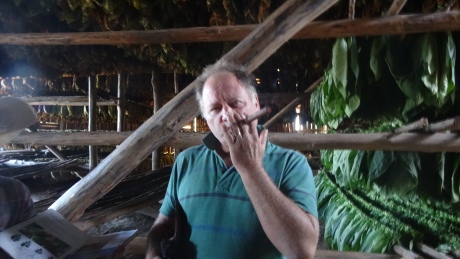
Colin trying a cigar on the tobacco plantation, Vinales
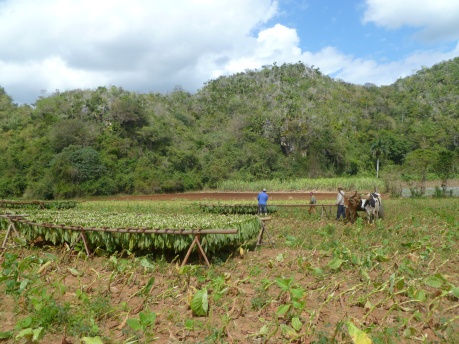
Tobacco still harvested like this in Vinales
Our next stop was in Playa Larga – chosen because it was a seaside resort and because of its close proximity to the infamous ‘Bay of Pigs’ (about which we had learned plenty in the Museum of the Revolution in Havana. As you would imagine, the Americans did not come out at all favourably). However, by the time we got to our Casa – a small, slightly shabby establishment run uber-enthusiastically by Meby and Roger, Chris and Colin were suffering from a tummy upset which seemed to run and run – unfortunately quite literally. Consequently we did not go to the Bay of Pigs museum or the beach (which were tantalisingly beautiful from the vantage point of our fully restored taxi mini-van driving along the coast road), but instead hot-footed it – stopping only for conveniences (so to speak) to our next stop, Trinidad.
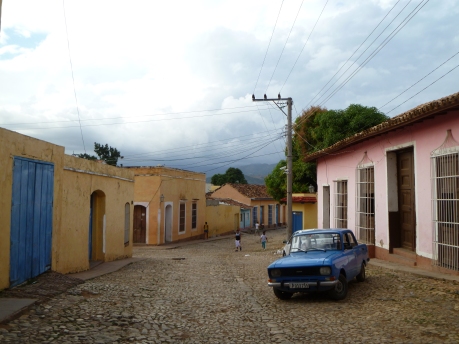
The cobbled streets of Trinidad, Cuba
What a treat was this Trinidad – such a far cry from its namesake island which had become so well known to us on our Caribbean excursions. From the guidebooks one might have thought this ancient town (yet another UNESCO World Heritage Site) was a tourist trap sort of place – cobbled streets, restored historic buildings and coach-loads of tourists deposited there every day. In fact, despite all the tourist bluster – and there is plenty – Trinidad has retained its character as a living, breathing hub of Cuban life. Founded in 1514, Trinidad was a major centre for plantation commerce including that of slave-trading of course, which made it an extremely prosperous city, good fortune still reflected in the fine buildings which still line street after cobbled street. Plazas are ringed with grand mansions and fine churches; shops and restaurants, bars and hostelries line the roads – so much so that it is difficult to believe you are not in a fine, old Spanish city.

A modern Cuban ‘train’, Trinidad Station.
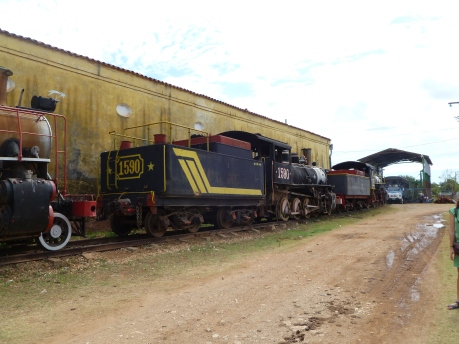
The steam trains left at Trinidad Station
Our Casa here was on the fringes of the old town, along a busy cobbled street. The Matriarch of the place, a larger than life lady called Zobeida (the Casa actually bore her name) ran her comfortable abode with an iron rod and was not given to any nonsense. However, she accommodated us well, offering a change of room when requested and allowing us to extend our stay, both to enable us to see more of the place but primarily because Colin was still ailing.
We had pre-booked a walking tour of the city through the agents but postponed it until Colin was able to come too. Now let me introduce you to Oswald our delightful and informative guide. He was a 21 year old, handsome young student whose English was extremely good, although, he told us, he had been discouraged from pursuing the language at school and college as it was not considered terribly useful. Ah, we said….but when the Americans come you will prove them all wrong as you will be in such demand. He was doubtful. He knew that President Obama was making friendly overtures to Castro, but was incredulous that such firm enemies could ever make a lasting or meaningful peace. Anyway, he sagely commented, whatever agreements Obama makes now may be reversed by the next incumbent to the Whitehouse. American capitalism was not something to be craved as it just made the rich richer and the poor poorer he said. Here was a chap, we thought, who was able to grasp the wider Cuban perspective on the world stage. He was interested to hear about the way things were done in Britain – amazed that good healthcare was free (as it is in Cuba) and our system of democracy could install a socialist, liberal or more right wing government depending on who was voted for by the people every 4-5 years…….and that personal wealth was not a factor for leadership. He walked us through Trinidad, commenting on the types of housing available to the populace, explaining the new freedom of being able to buy and sell a house, although the prices of some of the houses he pointed out to us seemed astronomical to him, but fairly realistic to us.
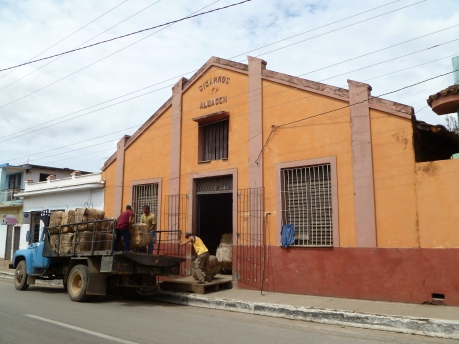
Tobacco leaves being delivered to cigarette factory, Trinidad
Oswald, more than anyone we had met in Cuba so far, was able to describe to us (albeit with a rather cynical spin) the Cuban way of life. Rubbing shoulders as he regularly did with English speaking tourists he had quite a large axe to grind about the lack of personal freedoms permitted, as he understood how different it was elsewhere. The internet, he explained was only available to those with a license to have it – schools and colleges, government establishments, travel agents etc. Even then, access was restricted. Wikipedia and other knowledge based sites were censored; Facebook was prohibited as was access to any overseas sites. His biggest grievance was the lack of freedom concerning travel. As a Cuban there were only three ways to leave the country – by dint of European ancestry which would then give you dual nationality; by marrying a foreign national or finally by securing a work contract with an overseas firm. Any such contract had to be scrutinised by the government and if you were permitted to leave they would take a proportion of the financial benefits. Doctors quite often made use of this scheme to go abroad on charitable endeavours as even working for a charity they would earn more than they could in Cuba. He explained too about the dual economy – the fact that everyone wanted to get their hands on the tourist CUC’s to improve their lifestyles – bit that even with a million CUC you still could not leave the country. Despite all this grim talk he was proud of his country and the revolutionary philosophy of looking after everyone in the country. He spoke angrily about the cuts the government were making to the list of things available by right by ration. “We will soon be capitalists if this continues“ he grumbled.
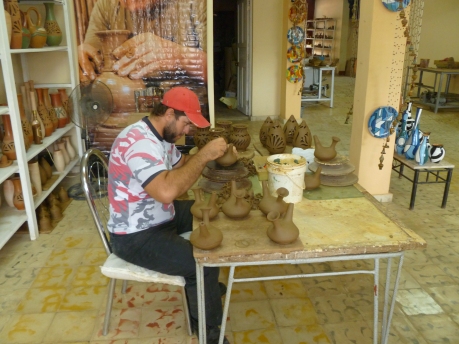
The pottery, Trinidad, Cuba
We walked a long way with Oswald. He took us to the railway station which we thought was an odd start to the tour. The trains of today were small tram-like diesel specimens with their little carriages (which the guard let us board to see the lack of comfortable seats or amenities) but more of interest were the massive Russian steam engines and tenders, sat on the sidings. These were mighty beasts shouting of former rail supremacy now long gone. We wandered through the back-streets of Trinidad where small cottages housed the citizens busily going about their business and calling “hola” as we passed. We went to the pottery which had been in business since Noah was a boy, using the same techniques it seemed. One of the workers took us round a corner to a loading bay and there, parked as though it belonged in such an anachronistic place was an old Model T Ford. The chap lovingly pulled out a rag and wiped the wheel arch….then surreptitiously asked us for a tip for showing it to us…..everybody wants those CUC’s! Of course we all bought some pretty pottery, then Oswald took us back through the town wearily. Now we felt we knew something of the real Trinidad and thanks to Oswald the real Cuba too.
The next day, after a final dinner at a wonderful restaurant where Colin was at last able to enjoy a meal – and risked a lobster at that –we had to head off once more. Our trusty driver Michel had left us and we were for a while driver-less – but eventually, after a few hours wait another was found and off we set in a far superior vehicle heading east through the deep lush Valle de los Ingenios, through the ancient town of Sancti Spiritus and onwards to Caminguey which we reached after dark. After a little confusion about our casa which had been changed because we spent an extra night in Trinidad and we had also requested an extra night in Camaguey. However, we were not disappointed when a very cheerful lady opened the door to a little terraced house in an old narrow street and declared that the whole house was ours! Upstairs there was a large double bedroom with a little terrace and ensuite; downstairs was a little kitchen and seating area and another large en-suite room. Perfect. She lived just next door. Tired though we were we headed out on foot that evening, finding a very nice restaurant (thank you Lonely Planet guide) tucked away down a cobbled street which opened into a small plaza. With excellent food and wine we were fortified and excited to see what this historic town had to offer.
As we had glimpsed the previous evening, Camaguey was a substantial city (the third largest in Cuba) and had a very particular 17th and 18th century grandiose colonial style. Why were we not surprised to learn that the city centre was granted UNESCO World Heritage status in 2008? Home to a population of former Spaniards, it has retained a very Spanish flavour both in architecture and atmosphere with its many plazas and churches (the city is the heart of Catholicism in Cuba apparently) joining warrens of narrow alleys and grander former residences. We spent a day exploring the museums, café’s and shops (this time focusing on the hunt for groceries to take back to Resolute) dodging the showers and returning in the evening to a restaurant very near our digs in a plaza under the gaze of the huge twin towered baroque edifice of Iglesia de Nuestra Senora del Carmen. We drank in the atmosphere there, reluctant to finish our delicious meal as our land tour of Cuba was nearly at an end.
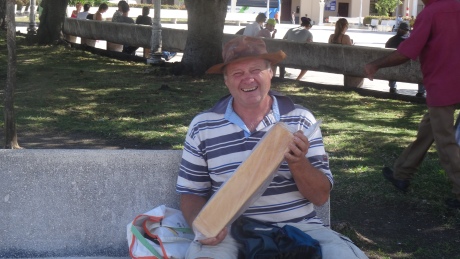
We found a loaf of bread, Hurray! Holguin.
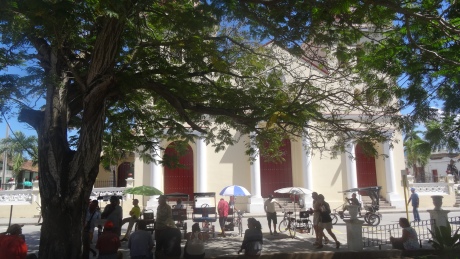
Bici-taxis outside the Cathedral, Holguin
Another day and yet another driver…..this time to take us back to Resolute at Marina de Vita. But there was one more treat in store. When Colin and I visited Holguin via a taxi from the marina, we had found a restaurant which we felt offered outstanding food and service – especially to us at the time as we had been living off such meagre rations for so long. Even having been to plenty of good eateries on our land tour we wanted to take Chris and Tanvi to this place – and to allow them briefly to see something of Holguin too, where our land journey had begun. We surprised ourselves by being able to direct the taxi to the restaurant, waited patiently for a table and sat down to enjoy our lunch. Unfortunately, this time the extensive menu which included the fillet mignon we had so enjoyed last time (beef is very rarely found in Cuba) had been laid bare by other hungry clientele. “No beef “said the waitress apologetically – oh no we collectively sighed (except Tanvi who was sitting pretty as she does not eat beef anyway!) However, other selections were made and we were not disappointed. Afterwards, full to bursting, we had a quick look at the city, then headed back to the taxi and on our way again to find dear Resolute waiting patiently for us at Marina de Vita.
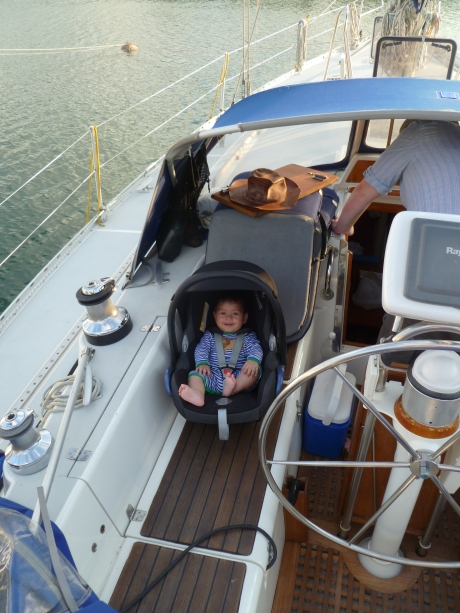
Charlie meets Resolute, Marina de Vita, Cuba
The few days we had left to us were spent relaxing on the boat enjoying our memories of the tour and giving Charlie his first experience of being aboard Resolute. Then, very sadly all too soon, their Lada was waiting to take them to the airport….accompanied by the inevitable tears and farewells.
All alone again we drew some deep breaths and turned our thoughts and plans towards the massive archipelago that is the Bahamas. Were we relieved at the prospect to be leaving Cuba after nearly two months? Honestly, yes. Our western sensibilities were desperate to be satisfied and mollified once again…….we wanted to see supermarkets with shelves piled high with produce…..rarities like bread and eggs and lettuce…..and, well, everything (except rice and beans); we wanted free access to the internet; freedom from all the stress-inducing, oppressive restrictions to our movements; freedom just to get up and go. But Cuba has taught us huge lessons: number one is that (obviously) communism is definitely not the answer in practice. But the historically familiar ‘power to the people’ revolutionary ideology of 1958, inspired as a knee-jerk reaction to the greedy, self satisfying, let-them-eat-cake philosophy of the ruling classes has to some degree made a very cohesive, proudly independent society, detached from the World as we know it , surviving happily in an insular bubble of equality and national self determination. One feels this bubble is due to burst at any time – whether from the external pressures being wrought upon it to conform (the first step of which could be by Obama’s recent open dialogue) and/or by internal combustion with the demise of the Castro brothers and their revolutionary generation. Some of the younger generation seem to have a restlessness and frustration with the old style leadership, despite still having patriotic ideals. They see glimpses of another very different world not far from their shores. Visitors like us, who seem so like them in many ways and not the demons they are led to believe inhabit the Capitalist universe, tell them tales of parallel lives lived so remarkably differently with a quality of life only dreamt of. Surely it cannot last…..but we have been privileged to glimpse this nation as it is.
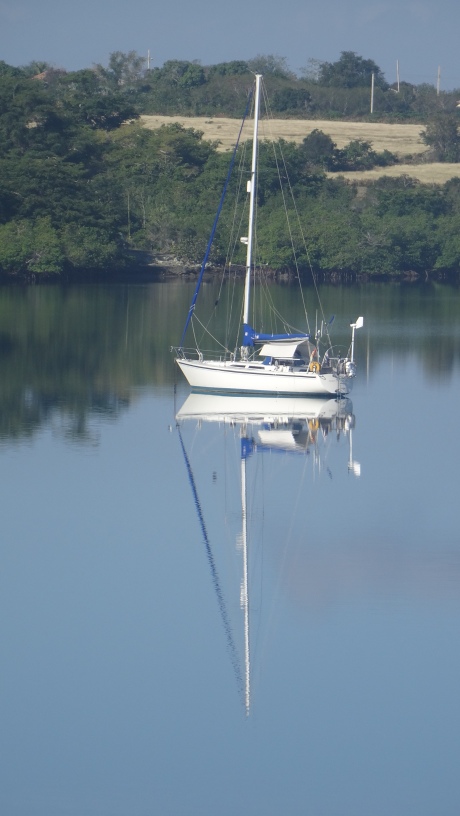
Resolute at anchor off Marina de Vita, Cuba

Another great blog. In fact I feel no need to go there now, you did it for me!